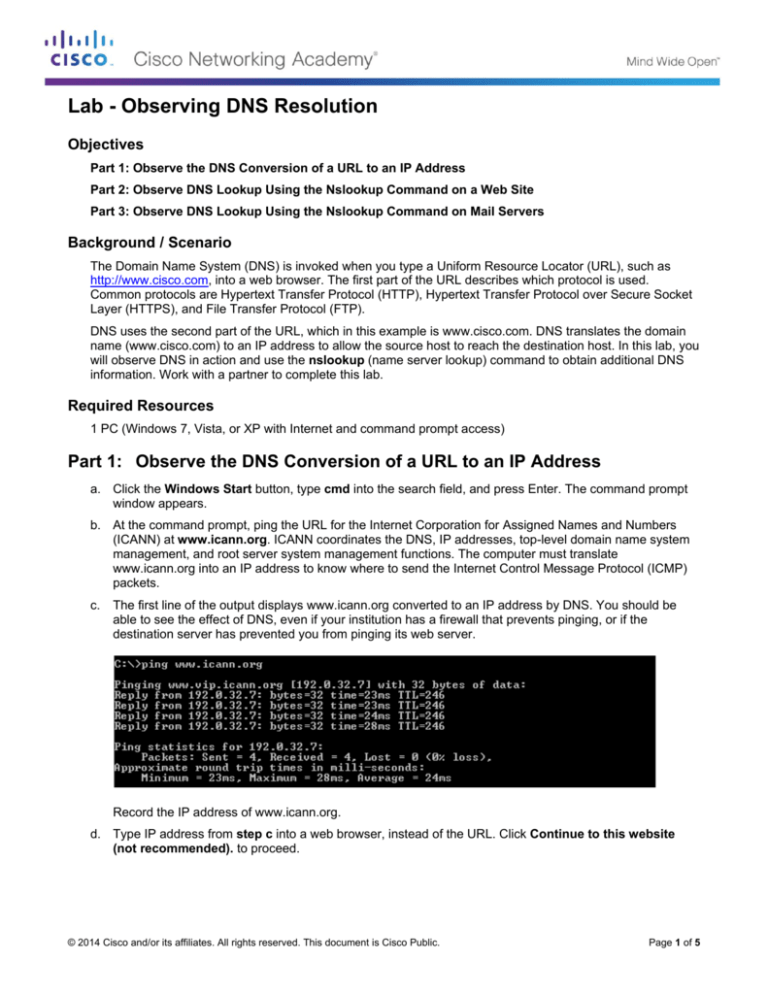
Lab - Observing DNS Resolution
Objectives
Part 1: Observe the DNS Conversion of a URL to an IP Address
Part 2: Observe DNS Lookup Using the Nslookup Command on a Web Site
Part 3: Observe DNS Lookup Using the Nslookup Command on Mail Servers
Background / Scenario
The Domain Name System (DNS) is invoked when you type a Uniform Resource Locator (URL), such as
http://www.cisco.com, into a web browser. The first part of the URL describes which protocol is used.
Common protocols are Hypertext Transfer Protocol (HTTP), Hypertext Transfer Protocol over Secure Socket
Layer (HTTPS), and File Transfer Protocol (FTP).
DNS uses the second part of the URL, which in this example is www.cisco.com. DNS translates the domain
name (www.cisco.com) to an IP address to allow the source host to reach the destination host. In this lab, you
will observe DNS in action and use the nslookup (name server lookup) command to obtain additional DNS
information. Work with a partner to complete this lab.
Required Resources
1 PC (Windows 7, Vista, or XP with Internet and command prompt access)
Part 1: Observe the DNS Conversion of a URL to an IP Address
a. Click the Windows Start button, type cmd into the search field, and press Enter. The command prompt
window appears.
b. At the command prompt, ping the URL for the Internet Corporation for Assigned Names and Numbers
(ICANN) at www.icann.org. ICANN coordinates the DNS, IP addresses, top-level domain name system
management, and root server system management functions. The computer must translate
www.icann.org into an IP address to know where to send the Internet Control Message Protocol (ICMP)
packets.
c.
The first line of the output displays www.icann.org converted to an IP address by DNS. You should be
able to see the effect of DNS, even if your institution has a firewall that prevents pinging, or if the
destination server has prevented you from pinging its web server.
Record the IP address of www.icann.org.
d. Type IP address from step c into a web browser, instead of the URL. Click Continue to this website
(not recommended). to proceed.
© 2014 Cisco and/or its affiliates. All rights reserved. This document is Cisco Public.
Page 1 of 5
Lab - Observing DNS Resolution
e. Notice that the ICANN home web page is displayed.
Most humans find it easier to remember words, rather than numbers. If you tell someone to go to
www.icann.org, they can probably remember that. If you told them to go to 192.0.32.7, they would have
a difficult time remembering an IP address. Computers process in numbers. DNS is the process of
translating words into numbers. There is a second translation that takes place. Humans think in Base 10
numbers. Computers process in Base 2 numbers. The Base 10 IP address 192.0.32.7 in Base 2 numbers
is 11000000.00000000.00100000.00000111. What happens if you cut and paste these Base 2 numbers
into a browser?
© 2014 Cisco and/or its affiliates. All rights reserved. This document is Cisco Public.
Page 2 of 5
Lab - Observing DNS Resolution
f.
Now type ping www.cisco.com.
g. When you ping www.cisco.com, do you get the same IP address as the example, or a different IP
address, and why?
h. Type the IP address that you obtained when you pinged www.cisco.com into a browser. Does the web
site dlsplay? Explain.
Part 2: Observe DNS Lookup Using the Nslookup Command on a Web Site
a. At the command prompt, type the nslookup command.
What is the default DNS server used?
Notice how the command prompt changed to a greater than (>) symbol. This is the nslookup prompt.
From this prompt, you can enter commands related to DNS.
At the prompt, type ? to see a list of all the available commands that you can use in nslookup mode.
b. At the nslookup prompt, type www.cisco.com.
© 2014 Cisco and/or its affiliates. All rights reserved. This document is Cisco Public.
Page 3 of 5
Lab - Observing DNS Resolution
What is the translated IP address?
Is it the same as the IP address shown with the ping command?
Under addresses, in addition to the 23.1.144.170 IP address, there are the following numbers:
2600:1408:7:1:9300::90, 2600:1408:7:1:8000::90, 2600:1408:7:1:9800::90. What are these?
c.
At the prompt, type the IP address of the Cisco web server that you just found. You can use nslookup to
get the domain name of an IP address if you do not know the URL.
You can use the nslookup tool to translate domain names into IP addresses. You can also use it to
translate IP addresses into domain names.
Using the nslookup tool, record the IP addresses associated with www.google.com.
© 2014 Cisco and/or its affiliates. All rights reserved. This document is Cisco Public.
Page 4 of 5
Lab - Observing DNS Resolution
Part 3: Observe DNS Lookup Using the Nslookup Command on Mail
Servers
a. At the prompt, type set type=mx to use nslookup to identify mail servers.
b. At the prompt, type cisco.com.
A fundamental principle of network design is redundancy (more than one mail server is configured). In
this way, if one of the mail servers is unreachable, then the computer making the query tries the second
mail server. Email administrators determine which mail server is contacted first using MX preference (see
above image). The mail server with the lowest MX preference is contacted first. Based upon the output
above, which mail server will be contacted first when email is being sent to cisco.com?
c.
At the nslookup prompt, type exit to return to the regular PC command prompt.
d. At the PC command prompt, type ipconfig /all.
e. Write the IP addresses of all the DNS servers that your school uses.
Reflection
What is the fundamental purpose of DNS?
© 2014 Cisco and/or its affiliates. All rights reserved. This document is Cisco Public.
Page 5 of 5












